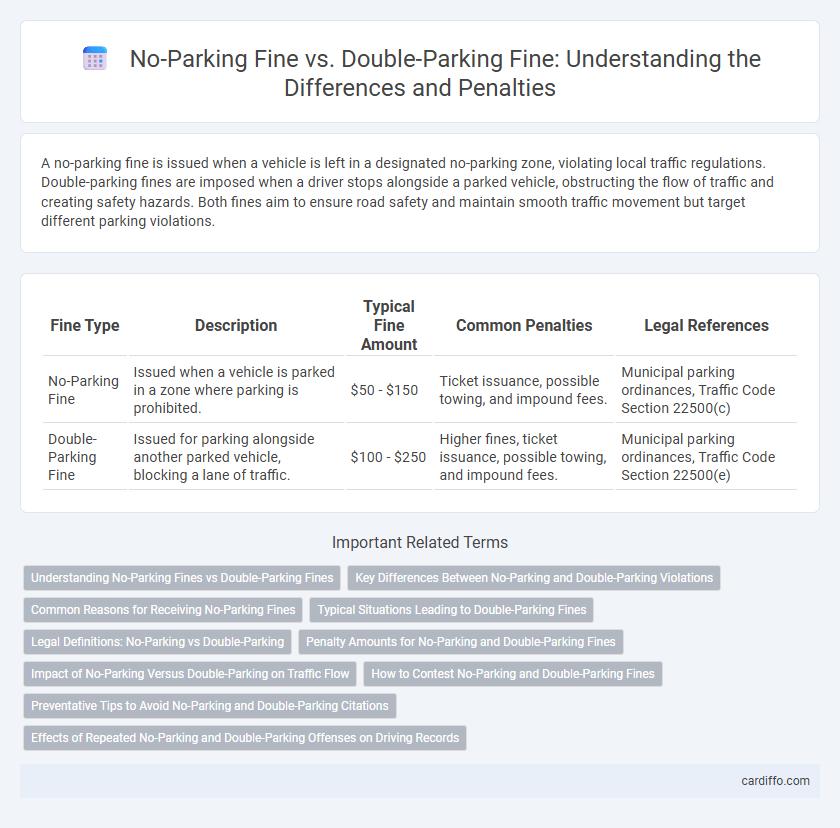A no-parking fine is issued when a vehicle is left in a designated no-parking zone, violating local traffic regulations. Double-parking fines are imposed when a driver stops alongside a parked vehicle, obstructing the flow of traffic and creating safety hazards. Both fines aim to ensure road safety and maintain smooth traffic movement but target different parking violations.
Table of Comparison
| Fine Type | Description | Typical Fine Amount | Common Penalties | Legal References |
|---|---|---|---|---|
| No-Parking Fine | Issued when a vehicle is parked in a zone where parking is prohibited. | $50 - $150 | Ticket issuance, possible towing, and impound fees. | Municipal parking ordinances, Traffic Code Section 22500(c) |
| Double-Parking Fine | Issued for parking alongside another parked vehicle, blocking a lane of traffic. | $100 - $250 | Higher fines, ticket issuance, possible towing, and impound fees. | Municipal parking ordinances, Traffic Code Section 22500(e) |
Understanding No-Parking Fines vs Double-Parking Fines
No-parking fines are issued when a vehicle is stopped or parked in a designated no-parking zone, often resulting in fixed penalties set by local traffic authorities. Double-parking fines incur higher charges due to the obstruction caused by a vehicle parked alongside another, blocking traffic flow and creating safety hazards. Understanding these distinctions helps drivers avoid violations and associated financial repercussions effectively.
Key Differences Between No-Parking and Double-Parking Violations
No-parking fines are issued when a vehicle is stopped or parked in a designated no-parking zone, restricting access or violating specific traffic signs, often resulting in moderate penalties. Double-parking fines apply when a vehicle is parked alongside another parked car, obstructing traffic flow and emergency vehicle access, typically leading to higher fines and more severe enforcement measures. The key difference lies in the location and impact of the violation: no-parking restricts parking in prohibited areas, while double-parking directly disrupts traffic movement and safety.
Common Reasons for Receiving No-Parking Fines
Common reasons for receiving no-parking fines include parking in restricted zones such as bus stops, fire hydrants, or areas with signage prohibiting parking during specific hours. Vehicles parked blocking driveways, crosswalks, or emergency access points also frequently incur no-parking fines. Ignoring municipal regulations related to curb colors, such as red or yellow zones, often results in fines designed to maintain traffic flow and public safety.
Typical Situations Leading to Double-Parking Fines
Double-parking fines typically arise in busy urban areas where drivers block active traffic lanes to pick up or drop off passengers, especially near commercial zones, schools, and transit hubs. Delivery vehicles often incur double-parking penalties when unloading goods on streets without designated loading zones, causing temporary traffic obstructions. Unlike no-parking fines, which penalize stationary vehicles in prohibited areas, double-parking fines specifically address the hazards and congestion created by obstructing traffic flow.
Legal Definitions: No-Parking vs Double-Parking
No-parking fines are issued when a vehicle is stopped or parked in a designated no-parking zone, which is legally defined as areas where stopping or standing is prohibited to maintain traffic flow or safety. Double-parking fines occur when a vehicle is parked alongside another vehicle already parked at the curb, obstructing the traffic lane and violating city traffic codes designed to prevent congestion. Both fines are enforced under municipal traffic regulations, but no-parking violations focus on restricted zones, while double-parking penalties address improper positioning that blocks moving traffic.
Penalty Amounts for No-Parking and Double-Parking Fines
No-parking fines typically range from $25 to $75, varying by city regulations, while double-parking fines are generally higher, often between $50 and $200 due to increased traffic obstruction risks. Municipalities impose stricter penalties on double-parking to discourage hazardous blockages that impede traffic flow and emergency vehicle access. The disparity in penalty amounts reflects the greater severity and impact of double-parking violations compared to no-parking infractions.
Impact of No-Parking Versus Double-Parking on Traffic Flow
No-parking fines target vehicles stopping in designated no-parking zones, generally causing minimal disruption to traffic flow since vehicles remain stationary and off travel lanes. Double-parking fines address vehicles blocking active traffic lanes, significantly impeding traffic movement and increasing congestion and delays. Enforcement of double-parking fines is critical for maintaining smoother traffic flow and reducing bottlenecks in urban areas.
How to Contest No-Parking and Double-Parking Fines
To contest no-parking and double-parking fines effectively, gather photo evidence showing clear signage or absence of restrictions at the violation site. Submit a formal appeal to the local traffic authority or parking violations office within the specified deadline, including supporting documentation such as parking permits or proof of emergency. Maintain records of all correspondence and consider attending a hearing if the initial appeal is denied to present your case in person.
Preventative Tips to Avoid No-Parking and Double-Parking Citations
To prevent no-parking fines, always check for clear signage and curb markings indicating parking restrictions, and avoid stopping in zones reserved for specific uses such as bus stops or fire hydrants. For avoiding double-parking citations, ensure your vehicle is completely within a designated parking space and never block traffic lanes, which can disrupt traffic flow and increase your risk of ticketing. Utilizing parking apps or city parking maps can also help identify legal parking areas and reduce the likelihood of fines.
Effects of Repeated No-Parking and Double-Parking Offenses on Driving Records
Repeated no-parking offenses typically result in escalating fines and points on a driving record, increasing insurance premiums and the risk of license suspension. Double-parking violations carry more severe penalties due to their impact on traffic flow and safety, leading to heavier fines and more significant marks on driving records. Accumulating multiple offenses in either category can cause long-term negative effects on driving privileges and financial liabilities for drivers.
No-parking fine vs Double-parking fine Infographic

 cardiffo.com
cardiffo.com